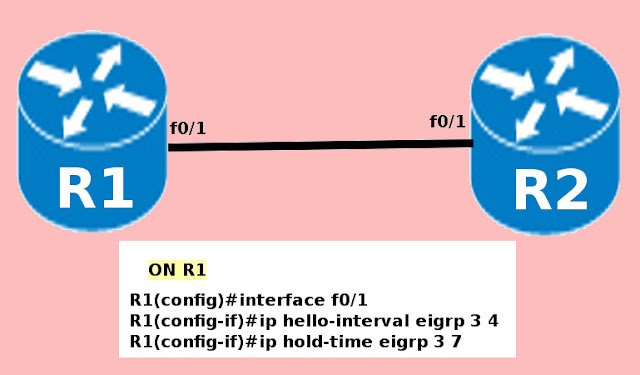Eigrp learns the best routes by forming the neighborship with other routers that are on the same subnet, exchanging topology data from neighbors and choosing the best route from the topology table and placing it in the IP routing table.
So the successful creation of neighborships is very important in eigrp.
Tuning of EIGRP Hello and Hold Timers
Eigrp convergence depends on the Hello and Hold timers of the hello messages. By changing the Hello and Hold timers we can change the eigrp convergence time.
Hold Time:
The time for which the router waits to receive a hello message before declaring the neighbor down is called the holdtime. The default value of hold time is 15 seconds.
Hello Time:
The time period after which the router sends a next hello message to its neighbor. The default value of hello time is 5 seconds. The router sends a hello message to its neighbor for every 5 seconds.
Configuring Hello and Hold timers
we can configure the hello and hold timers using the commands ip hello-interval eigrp and ip hold-time eigrp in the interface configuration mode.
The hello and hold timers can be verified by using the commands "show ip eigrp interface <type number >detail " or " show ip eigrp neighbors" and "show running-config" commands.
Passive Interfaces
We can make the Eigrp enabled interface passive by using the "passive-interface" command. On a passive interface Eigrp does not send any Eigrp messages(unicast or multicast) and thus does not form the neighborships on this interface.But the connected subnet of the passive interface will be advertised by the Eigrp.
EIGRP Authentication
EIGRP supports MD5 authentication only and does not support clear text authentication.while using authentication, every eigrp message should be authenticated by the eigrp router.
The MD5 hashing algorithm is a one-way cryptographic function that accepts a message of any length as input and returns as output a fixed-length digest value to be used for authenticating the original message.
Both the sending and receiving routers should use the same preshared key(PSK), to generate an MD5 digest for every eigrp message.
If the authentication fails, then the router discards the message and the two routers does not become neighbors.
EIGRP Authentication configuration
The first step is to create an authentication key chain. For this we have to provide key chain name,key number, and key-string value using the commands "key chain ", "key " and "key-string"
In the second step we have to enable EIGRP MD5 authentication using the command "ip authentication mode eigrpmd5" interface subcommand.
In the third step we have to point the roght key chain to be used using the "ip authentication key-chain eigrpinterface subcommand.
In the second step we have to enable EIGRP MD5 authentication using the command "ip authentication mode eigrp
In the third step we have to point the roght key chain to be used using the "ip authentication key-chain eigrp
As we can understand from the above configuration steps, we can have multiple keys and each key is represented by its number.We can configure a lifetime for each key for which it is valid. If no lifetime is configured then the key is valid for any point of time.
EIGRP Static Neighbors
In EIGRP, we have the option to define the neighbors manually by using the command "neighbor " in EIGRP router subcommand.In the above command the ip address is the interface ip address of the neighboring router.
When we statically define the neighbors, the EIGRP messages are sent as unicasts.
EIGRP Metric Components
By default, EIGRP metric is calculated by using bandwidth and delay. We can modify this by adding additional parameters like link reliability and link load. For doing this we have to configure five constants called k-values, which are used in the metric calculation as constants k1,k2,k3,k4 and k5.
EIGRP Router-ID
The EIGRP router-id is a 32-bit number used to represent each router. The RID is determined when the EIGRP process start.
EIGRP follows the below rules to select the RID
1)If a router id is manually configured by using the command "eigrp router-id " then this will be chosen as the RID.
2)Second preference is given to the highest IPv4 address of a loopback interface which is in up/up state.
3)Last preference is given to the highest IPv4 address of an non-loopback interface in the up/up state.

